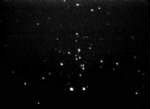 ----
----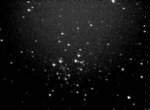 ----
----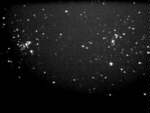
Deep Sky (Web Cameras)
Now I've got a Quickcam Grayscale (August 2000), I'm able to take photographs of clusters and faint objects. My first attempts with the grayscale have been taken afocally with the lens and infrared filter in place. Thanks to Dave Allmon who is the master of this camera, for his help and the use of his software. All photographs taken with the Celestron C8, the open clusters with a 26 mm eyepiece, M 13 and M 57 with a 17 mm eyepiece. There was substantial sky glow at the time, less noticeable in M 57 which was near the Zenith.
 ----
---- ----
----
 ----
----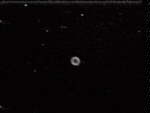
In the early hours of August 28th. , the skies cleared beautifully, allowing me to take my first Cassegrain focus deep sky images with my Grayscale camera. All the following were 20 x 30 second uncooled exposures, stacked and processed in DarkGen. I had a further set of 1 minute images of M57, but these got corrupted during processing - mea culpa! Pity because they were good in preview. Perhaps another night, then this text will change! NGC 404 is a small galaxy close to beta Andromedae (Mirach). It's difficult to see through the telescope because of the proximity of the bright star. I've captured the core and some of the nebulosity. The faint (magnitude 16.1) unnamed star in the M57 picture was identified from the annotated photograph on page 102 of the September 2001 Sky and Telescope magazine.
 ----
----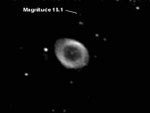 ----
----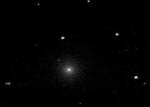
|
This enlargement of the central area of M15 shows the small planetary nebula Pease1
|
|
The first target, in the early hours of 19th. September 2000, after I rehashed my Grayscale Camera to use with a cooling fan was NGC 6826, the 'Blinking' planetary nebula, so called because it appears to wink on and off when viewed through the eyepiece as it moves in and out of averted vision. This is due to the faintness of the halo in comparison to the bright centre. | |
|
Very few of the stars imaged in this picture are identified in Skymap. Juergen Liesmann kindly supplied this inverted version with the magnitudes of most of the fainter stars. |
|
The next planetary nebula I tried was the 'Cats Eye' nebula (NGC 6543) in Draco. There is a famous Hubble picture showing superb detail and colour of course, nevertheless my humble effort shows the basic structure. Taken on September 21st. 2000. The sky is quite empty of stars around this nebula, the faintest (barely visible) of the three stars in the image being mag. 14.3. Cassegrain focus of the C8. |
|
The Andromeda Nebula, M31, is an obvious target , and I tried for it in the early hours of 28th. October. Because of the large expanse, I used a 58 mm camera lens. M32 and M110 are also captured. Faintest stars around mag. 12 - 13. Unfortunately the lens seems to have introduced substantial halo around many of the stars. More work needed! |
|
In April 2001 with Canes Venatici high in the sky I attempted to image M51 using my recently purchased LX90. The first attempt on 23rd. was spoilt by high levels of light pollution, but a later try on 30th. obtained this result. Still hazy, partly light pollution from my urban environment, partly scatter due to the afocal arrangement I used, Grayscale with its own lens and a 17 mm eyepiece. 6 x 60 second exposures, stacked and processed using Darkgen and Photoshop. I 've now (June) bought a 0.63 reducer which will enable Cassegrain focus imaging of the smaller galaxies, and give better results. But this will have to wait - the Summer skies are too bright. |
|
Here are a couple more well known Messier galaxies, M82 in Ursa Major and M64 - the 'Blackeye' galaxy in Coma Berenices, captured on 26th. and 30th. April 2001 respectively. Both these galaxies have distinctive dark lanes. |
The advent of Stephen Chambers' modification to the Vesta Pro series of Web Camera opened a new world of low cost deep sky colour CCD imaging. Here are a selection of the early photographs taken with this camera:
|
A spell of bad weather, then the odd chance in November 2001. Comet LINEAR 2000WM1 was rapidly heading south through Aries, and my cooled Vesta Pro did sterling service on a couple of occasions. I also captured M82 in colour, but still from my light polluted location. It seems that every time I try to get the camera to a dark sky the weather lets me down - there must be clouds in the camera box! |
24th. November 2001, 19:23-19:43 UST |
26th. November 2001, 01:12-01:45 UST |
26th. November 2001, 0230 UST |
Both the above comet pictures are stacked from shots taken over time periods during which this fast moving comet travelled appreciably relative to the background stars, which are therefore seen as trails in the stacked images. I've produced an animation of the second picture (26th. November) showing the movement over the 33 minute time period. About 4 1/4 arc minutes, representing a speed of around 80,000 mph. The Earth to the Moon in 3 hours!! Two versions of the animation are available, a small version (274 KB) and a larger version (1.82 MB). The coordinates of the comet at 01:30 were RA 2h 14m 43 secs., DEC + 20° 59' 27". Camera at prime focus of ST80, piggybacked on LX90.
M51
|
A spell of fine weather, and at last to a dark site (Derwent Reservoir - see Light Pollution map) on 7th. April . Better contrast and more colour, but there was a lot of moisture in the sky, and the finer details are a little blurred. 18 frames, settings as the previous image above. |
|
Later that night, I took a few frames of M65 and M97 (the Owl planetary nebula) . Settings as above. M97 was almost invisible on the laptop screen, but later processing brought it up, albeit a bit grainy.
|
|
One of the main reasons for going out that evening was to photograph the Comet Ikeya-Zhang. Prime focus with Mogg reducer on the 80 mm Refractor piggybacked on the LX90. Two sets of 30 second images stitched together. There are numerous 13th magnitude stars visible in this image. |
|
Another couple of galaxies from mid April 2002. M61 exhibits unusual irregularity in the spiral arms - perhaps an old collision. Blackeye M64 well known, and a much better image than my earlier Greyscale attempt above. |
|
M27 - the Dumbbell planetary nebula - is a prime target, but until July 2002 I haven't been successful in imaging it. Then a clear spell and use of my LPR filter at Boldon eventually resulted in this image. Only 5 frames of 60 secs. at f4, before thin cloud stopped the session, but it'll do for now!! |
|
A couple of days later, and the weather was more kind! I was able to capture numerous frames of both M13 and M27 during the period of astronomical twilight. 11th. July 2002. Vesta Pro (uncooled - Peltier failed!), from Boldon using LPR Filter. |
LX90 at f4. |
LX90 at f 6.3. |
|
August 15th. 02 was the first good clear sky for some time during a spell of very poor weather, and I was able to get out to a dark site. Comet C/2002 04 Hoenig was the prime target, but first I had a go at imaging M31 with the cooled amp-off Vesta piggybacked, using the same 58 mm camera lens used for the older Greyscale shot above. Stopping down to f 6.3 much improved the star images, and 2 minute exposures were possible. Perhaps even longer would have shown more detail in the galaxy itself, but the image is passable for now! 6 x 2 minute frames, taken and stacked in AstroVideo |
|
Comet Hoenig , although classified as mag 9.5 was disappointingly faint in the eyepiece of my LX90, but I had a go at imaging anyway. A fast moving object! The fully stacked image clearly shows the movement against the background stars - because the images are aligned on the comet, the stars appear as trails. The break in the trails was due to a computer glitch - I had to stop and restart imaging. Total time between first and last frames is 20 minutes. Two animation sizes, medium (108K - click on image) and large (342K) |
|
When I came to process the images, I noticed that one of the frames held a faint trail, possibly that of an artificial satellite or meteor. A bit of research identified it conclusively as the path of the Cosmos 1400 satellite, which passed through the field of view in about 1/7th. second! This and all the frames used were 60 secs at f6.3, cooled amp-off Vesta Pro web camera. |
|
I recently acquired a secondhand camera lens, 135 mm focal length, f2.8, which I wanted for imaging medium size objects. Perfect for the Pleiades. The 'star' patterns on the brighter stars are diffraction spikes caused by the lens diaphragm when stopped down to f4.5 for the images - this was necessary to obtain round star images, at full aperture they were triangular! The image was taken from Boldon, using an Infra-Red blocking filter. 20 images x 90 seconds. Some nebulosity apparent, but a trip to a dark site is needed to do better . Star magnitudes down to 13.5 |
|
17th. December and at last clear skies. With of course a near full Moon! But I decided to give M42 a try, and by combining 10,20,40 and 90 second images to preserve the Trapezium area, and subtracting sky glow as a dark frame, this was the result. From a dark site on a dark night.... Vesta Pro and LX90, f4, Light Pollution and Infrared block filters.
|
|
Here's a NGC 891 I overlooked from earlier in the year. Vesta Pro with LX90 at f4. The picture wasn't trailed vertically - during processing the brighter stars developed black 'ears' either side which when removed (using L'Oreal) left them looking oval - they were originally round! And the head of Comet C/2002 V1 NEAT |
|
Here's an M1 I overlooked from 4th. February 2003. The filaments aren't particularly clear, but there is good colour which I might be able to use on a MX716 image when the time comes:-) |
|
In the early hours of 17th. September, having given up on Mars due to bad seeing (again!), I decided to try for the Little Dumbbell or Cork Nebula - M76 in Perseus, with my Cooled Vesta Pro. Light Pollution and a bright last quarter Moon, so I used my LPR filter. LX90 at f6.3. I found it necessary to take (unguided) images of 90 seconds , but the LX behaved itself, and I obtained 14 well tracked frames which stacked (I used Astrovideo) to give this result. A little grainy, mainly due to the residual sky glow. |
|
This M57 - my best colour one, was summed on the night 23-24 September from 1 minute frames using AstroVideo. |